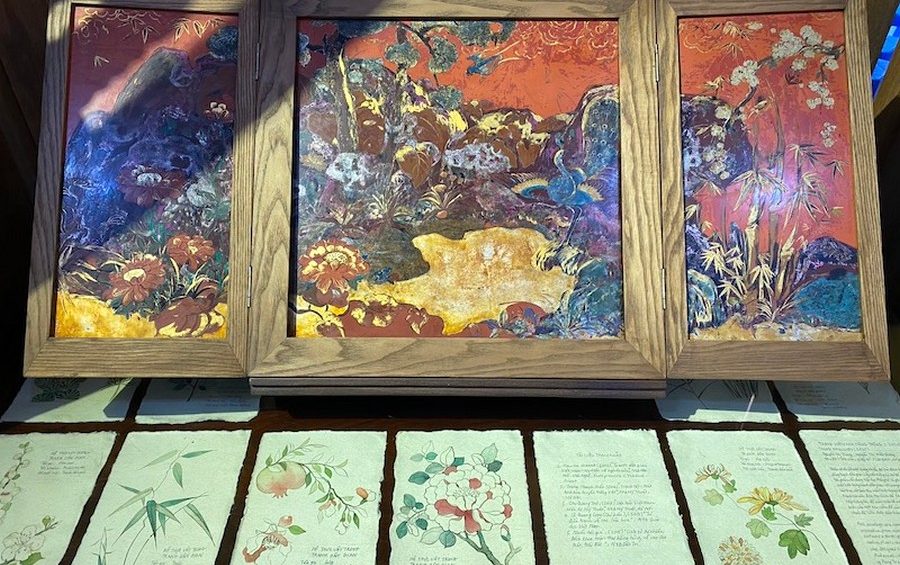Vietnamese folk paintings are a combination of traditional cultural values with ancient artistic methods that have been created through generations. The folk paintings are indispensable ornaments of ancient Vietnamese family at Tet (Lunar New Year) or for worshipping.
Hang Trong folk painting

Hang Trong painting is a genre of Vietnamese woodcut painting that appeared 400 years ago as religious and Lunar New Year hanging pictures. The paintings originated from the area of Hàng Trống in the Old Quarter of Hanoi covers topics such as social and cultural practices or illustrates popular folk tales. The most famous Hang Trong paintings are Ngu ho (the Five Tigers), Tu Phu (the Four Palaces), Tam Phu (the Three Palaces), and Tu Quy (Four Seasons) usually used for worshipping. However, there are also paintings with folk themes such as Bit Mat Bat De (Blind Man’s Buff), or Thay Do Coc (The Toad Scholar) used for the family decoration of families during the Tết holiday.
The art of making Hang Trong paintings is always considered a symbol of traditional culture and aesthetic value of Vietnam.In making a Hang Trong painting, the craftsman starts with woodblocks to print black outlines, then draws the details and finally colours the picture in by hand. Because the main part of the process is made by the craftsman’s hands, Hang Trong pictures are slightly different from one to another. The paper used in making Hang Trong painting is called Xuyến Chỉ paper. Hang Trong craftsmen colourize pictures with pigments, and therefore the tone of Hang Trong paintings is usually bright and attractive with principal colours being pink, blue, green, red and yellow.
Dong Ho folk painting

Dong Ho painting is also the other famous genre of Vietnamese folk painting originated in the Red River Delta. Dong Ho paintings reflect people’s innermost wishes, ideas and simple dreams. Therefore, unlike Hang Trong paintings, they are available throughout the country, from the villages to the capital city. In the past, Dong Ho painting used to be a precious decoration particularly to celebrate Tet Holiday. Vietnamese bought Dong Ho pictures and hang them on their wall for a year, and then replaced them with new ones for a new year. Everyday life, folk allegories, signs of happiness, luck and prosperity are main subjects of the painting. Some famous Dong Ho pictures like the Pig Herd, Hen Surrounded by Chickens, the Wedding of the Rat, Scene of Wrestling, or Scene of Catching Coconuts would be your best choice for a gift.
The most special feature of Dong Ho paintings is that it uses diep powder coat on the paper. It is a white powder made from the shells of diep, a kind of river scallop to make silver lustre glitter. On the background, the colours are applied with a woodblock. Some of the paintings only have simple black lines, while others are printed with one other colour. All of the materials for creating the colours for these paintings come from nature. A wide spectrum of colours can be made using mixing and multi-coloured printing techniques. You can visit Dong Ho village to experience the making of the paintings or buy some pictures at the Old Quarter in Hanoi.
Kim Hoang paintings

Kim Hoang paintings, or red paintings, are made on the outskirts of Hanoi since 18 century. Kim Hoang paintings are printed and drawn on imported coloured paper, usually bright red or yellow, and printed with black lines and shapes; other colours used to separate the shapes. Sometimes, the paintings are reprinted to create clear lines. The themes of Kim Hoang paintings are similar to those of the Dong Ho paintings, but there are also Chinese characters such as Phuc, Loc,Tho (meaning “Happiness”, “Good Luck”, and “Longevity”), that have the typical seasonal flowers printed next to each character. By 1945 Kim Hoang painting has been lost in a great flood. Now you can find them when visiting Vietnam Fine Arts Museum in Hanoi.










